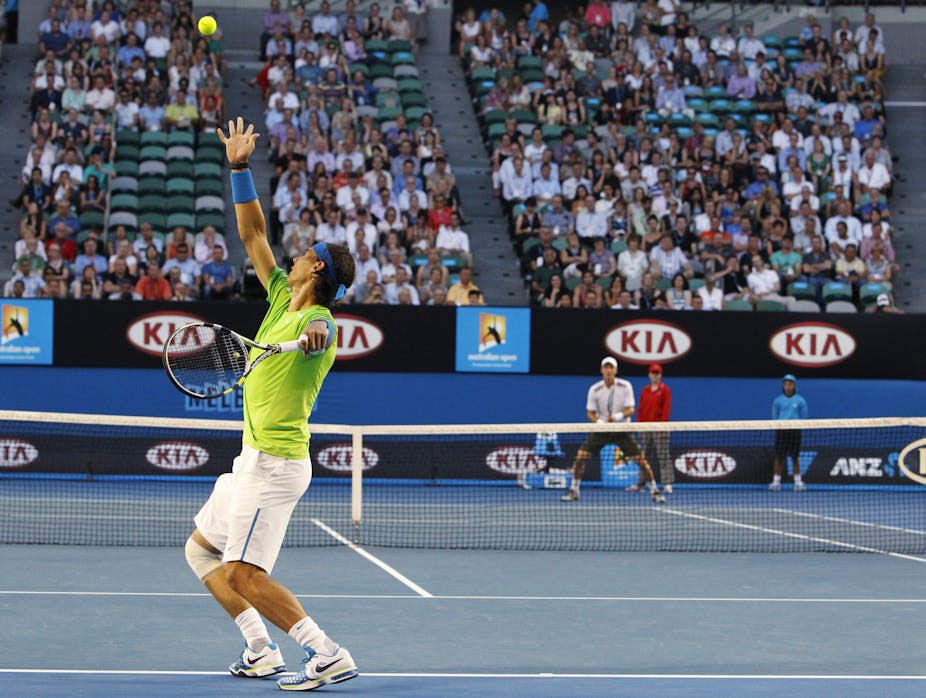With the Australian Open into its final few days, we’re starting to see the best tennis players in the world come to the fore. And to be the best in the world, you need a well-rounded game, including a powerful serve.
But how much of a role does a powerful serve play when you get toward the end of a tournament? Is there a relationship between serve speed and ultimate tournament success? Does court surface play a role in determining the effectiveness of a serve?
The four major Grand Slam tennis tournaments are contested on a range of surfaces: two hard courts (Australian Open and US Open), one grass (Wimbledon), and one clay (French Open). The red clay courts at Roland Garros in Paris are softer and slower than the hard courts at the US Open.
If the speed of a tennis ball is reduced when it bounces on a clay surface, then do players with fast, powerful serves enjoy more success at, say, the US Open than at the French Open? And is the average (first or second) serve speed notably greater for match winners than for losers, regardless of any court surface?

To find answers to these questions, my colleagues and I compared the paired difference between the winner’s and loser’s first and second serve speed in each match of each round of play at the 2010 US Open and the 2011 French Open. In other words, we subtracted average second serve speed from average first serve speed for both the winner and loser of each match, and compared the two resulting numbers.
If serve speed matters then the average paired difference between the winner’s and loser’s first (or second) serve speed should be greater than zero.
We were also curious to see if the difference in the average speed between the first and (typically more conservative) second serve was different for match winners than for losers.
Perhaps this difference is smaller for the match winner, suggesting the winner gives up little speed (or power) between his or her first and second serves. Then again this difference could be larger for the match winner if he or she gives up considerable speed (or power) to get the second serve in (and avoid getting a double fault).

The results of these tests, for the various rounds of play for women’s and men’s singles in the 2010 US Open, can be found in Tables l and 2 (speeds here are expressed in miles per hour). Tables 3 and 4 contain similar data from the 2011 French Open (speeds here are expressed in kilometers per hour).
Table 1 (above) shows that, in the 2010 US Open, women who won their singles matches had significantly faster average first and second serve speeds than their opponents. Most results are significant through the fourth round, but not thereafter. In other words, a big serve is a valuable weapon in the opening rounds, but less so in the finals.
Table 2 (below) shows that serve speed only made a marginal difference to the outcome of Round 1 matches in men’s singles. And, for neither men nor women did the difference between first and second serves drop off more (or less) for match winners than for losers.
The women’s and men’s singles results for the 2011 French Open are reported in Tables 3 and 4, respectively. Among the women, none of the results for average first or second serve speed were statistically significant. That is, there seemed to be no real relationship between serve speed and tournament success.
But on the men’s side average first serve speed was considerably faster for winners than for losers, but only in the first two rounds of play. Again, a big serve was less of a deciding factor when it came to the business end of the tournament.

So a strong serve can help men in the early rounds of tournaments on slower clay surfaces (such as the French Open), but less so on harder surfaces (such as those found at the Australian Open). Conversely, women with mammoth serves are more likely to enjoy success in the early rounds of hard-court tournaments, but less so in soft-court tournaments.
Surprisingly, average (first or second) serve speed was not notably greater for match winners than for losers on either court surface in the quarterfinals, semifinals, or final title match.
All of this is to say that, at the end of the day (or tournament), a huge serve may not be the great equaliser. Serve speed, albeit important, is just one of many weapons in a tennis player’s arsenal.

This article was co-authored with three students in Middlebury College’s Department of Economics: David A. Farah, Johann N. Riefkohl and Alexandra L. McAtee. It first appeared in the Journal of Recreational Mathematics, Volume 36, Number 3.

